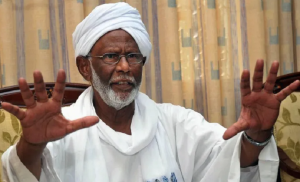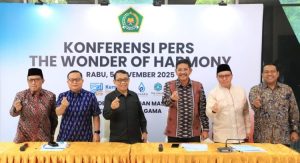 by Syarif Hidayat
by Syarif Hidayat
The Quran is a record of the exact words revealed by God through the Angel Gabriel to the Prophet Muhammad. It was memorized by Muhammad and then dictated to his Companions, and written down by scribes, who cross-checked it during his lifetime. Not one word of its 114 chapters, Suras, has been changed over the centuries, so that the Quran is in every detail the unique and miraculous text which was revealed to Muhammad fourteen centuries ago.
What is the Qur`an about?
The Quran, the last revealed Word of God, is the prime source of every Muslim’s faith and practice. It deals with all the subjects which concern us as human beings: wisdom, doctrine, worship, and law, but its basic theme is the relationship between God and His creatures. At the same time it provides guidelines for a just society, proper human conduct and an equitable economic system .
The Quran is the constitution of the Muslims from which they derive the teachings which organize both their religious and everyday affairs. It differs from the previous Divine Books in the following ways:
•It is the last Divine Book which was revealed, and for that reason, Allah, the Exalted, promised to protect it from any distortion until the Last Day.
Allah says:
(Indeed, it is We who have sent down this Reminder [i.e., the Quran] and indeed, it is We who are its Guardian. ) (15:9)
•The Quran includes all the legislations which reform society and guarantees happiness for all in its implementation.
•The Quran has documented the stories of the Prophets and Messengers, and what happened between them and their peoples, from Adam till Muhammad, may Allah exalt his mention.
•It was revealed to all of mankind so that they would live a life of peace and happiness, and to take them out of darkness and bring them into the light.
•Reciting, memorizing and teaching it are acts of worship.
Maurice Bucaille said in his Book:
Also Read: Egypt, Qatar Deliver Trump’s Gaza Ceasefire Proposal to Hamas
The Quran, and Modern Science: ‘A totally objective examination of it [the Quran] in the light of modern knowledge, leads us to recognize the agreement between the two, as has been already noted on repeated occasions.
It makes us deem it quite unthinkable for a man of Muhammad’s time to have been the author of such statements, on account of the state of knowledge in his day. Such considerations are part of what gives the Quranic Revelation its unique place, and forces the impartial scientist to admit his inability to provide an explanation which calls solely upon materialistic reasoning.’
If one assumes that the Qur’an is the product of a man’s mind, then one would expect it to reflect some of what was going on in the mind of the man who “composed” it. In fact, certain encyclopaedias and various books claim that the Qur’an was the product of hallucinations that Muhammad underwent. If these claims are true – if it indeed originated from some psychological problems in Muhammad’s mind – then evidence of this would be apparent in the Qur’an. Is there such evidence? In order to determine whether or not there is, one must first identify what things would have been going on in his mind at that time and then search for these thoughts and reflections in the Qur’an.
It is common knowledge that Muhammad (s) had a very difficult life. All of his daughters died before him except one, and he had a wife of several years who was very dear and important to him, who not only proceeded him in death but died at a very critical period of his life. As a matter of fact, she must have been quite a woman because when the first revelation came to him, he ran home to her, afraid. Certainly, even today one would have a hard time trying to find an Arab who would tell you, “I was so afraid that I ran home to my wife.” They just aren’t that way. Yet Muhammad (s) felt comfortable enough with his wife to be able to do that. That’s how influential and strong woman she was. Although these examples are only a few of the subjects that would have been on Muhammad’s mind, they are sufficient in intensity to prove my point.
Also Read: Israeli Airstrikes Kill 54 Palestinians Across Gaza
The Qur’an does not mention any of these things – not the death of his children, not the death of his beloved companion and wife, not his fear of the initial revelations, which he so beautifully shared with his wife – nothing; yet these topics must have hurt him, bothered him, and caused him pain and grief during periods of his life. Indeed, if the Qur’an was a product of his psychological reflections, then these subjects, as well as others, would be prevalent or at least mentioned throughout.
Allah says: (Allah creates the creation in the first instance, and then brings it forth anew: and, in the end, to Him you all will re- turn.) (30:11)
Allah clearly states in this verse that He is the One Who created and brought into existence all creatures in this universe from nothing. This is stated in the Quran, which is divine revelation from Allah. Allah describes the be- ginning of the universe saying: (The Originator of the heavens and the earth: and when He decrees a matter, He only says to it, “Be,” and it is.) (2:117)
Allah informs us in this verse that the universe was created from nothing, all that took place before it’s creation is from the knowledge of the unseen world, which only Allah knows. Human intellect is incapable of realizing and grasping what the substance matter of the first creation was, for Allah did not inform us of this knowledge. Man can only produce hypothesis and the- theories concerning ecological systems.
Also Read: School Bus Explosion in Pakistan Kills Five, Military Accuses India
.Allah says: (I did not make them witnesses of the creation of the heavens and the earth, nor of the creation of their own selves; and I would not have taken the misguiders as assistants.) (18:51)
Allah says: (Have those who disbelieved not considered that the heavens and the earth were one single entity, which We then parted asunder and made from water every living thing? Will they not, then, believe?) (21:30)
This verse makes unmistakable reference to the fact that Allah created the universe from a single entity, and He is All-Capable over all things. Allah then ordered this ‘single entity’ to split, which it did, and turned into a cloud of smoke. From this cloud of smoke Allah created the heavens and earth.
Modern astrophysicists assert that the entire universe originated from one entity, the result of what is known today as the ‘Big Bang’.
Allah says: (Then He (rose over) the heavens while it was something like smoke, and said to it and to the earth: ‘Come both of you willingly or unwillingly.’ They said, ‘We come willingly.) (41:11)
This verse affirms that the sky, during its early stages- was like smoke; this is also affirmed by modern science.
James H. Jeans said: ‘We have found that, as Newton first conjectured, a chaotic mass of gas of approximately uniform density and of very great extent would be dynamically unstable; nuclei would tend to form in it, around which the whole of matter would ultimately condense.’
Also Read: Half a Million People in Gaza on the Risk of Starvation: IPC
The Scientific Miracles in the Holy Quran
The Scientific Miracles in the Holy Quran
The Quran, which was revealed fourteen centuries ago, mentioned facts only recently discovered or proven by scientists. This proves without doubt that the Quran must be the literal word of God, revealed by Him to the Prophet Muhammad , and that the Quran was not authored by Muhammad or by any other human being. This also proves that Muhammad is truly a prophet sent by God. It is beyond reason that anyone fourteen hundred years ago would have known these facts discovered or proven only recently with advanced equipment and sophisticated scientific methods. Some examples follow.
THE MIRACLE OFTHE FEMALE HONEY BEE
Your Lord revealed to the bees: “Build dwellings in the mountains and the trees, and also in the structures which men erect. Then eat from every kind of fruit and travel the paths of your Lord, which have been made easy for you to follow.” From inside them comes a drink of varying colours, containing healing for mankind. There is certainly a Sign in that for people who reflect. (Qur’an, 16:68-69)
Also Read: Israeli Captive Says “Only a Deal Will Bring Us Home”
In the honey bee colonies where each of the many bees is assigned a specific task, the only exception is the male honey bee. The males do not contribute to the defence of the hive or its cleaning, to gathering food, or making of the honeycomb and honey. The only function of the male bees in the hive is to inseminate the queen bee.106 Apart from reproductive organs, the males possess almost none of the features possessed by the other bees and it is therefore impossible for them to do anything but fertilise the queen.
The worker bees carry the entire load of the colony. Although they are females like the queen, their ovaries have no maturity. This renders them sterile. They have several duties: cleaning the hive, maintaining the larvae and the young, feeding the queen bee and the males, producing honey, constructing the honeycomb and repairing it, ventilating the hive and safeguarding it, gathering supplies like nectar, pollen, water and resin, and storing these in the hive.
In Arabic, there are two different usages of verbs. By means of the usage, it is possible to determine whether the subject is a female or a male. As a matter of fact, the verbs (italic words) used for the honey bee in the verses are used in the format of the verb for females. Through this, the Qur’an indicates that the honey bees that work in the making of the honey are females.107
We should not forget that it is impossible for this fact to have been known about the honey bees in the time of the Prophet Muhammad (saas). Yet, Allah has pointed at this fact and shown us yet another miracle of the Qur’an.
Also Read: Al-Quds Brigades Seize Israeli Surveillance Drone Over Khan Younis
AL QU’RAN ON HUMAN EMBRYONIC DEVELOPMENT:
In the Holy Quran, God speaks about the stages of man’s embryonic development:
We created man from an extract of clay. Then We made him as a drop in a place of settlement, firmly fixed. Then We made the drop into an alaqah (leech, suspended thing, and blood clot), then We made the alaqah into a mudghah (chewed substance)… (Quran, 23:12-14)
Literally, the Arabic word alaqah has three meanings: (1) leech, (2) suspended thing, and (3) blood clot.
In comparing a leech to an embryo in the alaqah stage, we find similarity between the two. Also, the embryo at this stage obtains nourishment from the blood of the mother, similar to the leech, which feeds on the blood of others.
Also Read: Hamas Expresses Readiness for Comprehensive Deal with Israel for Hostage Release
The second meaning of the word alaqah is “suspended thing.” This is the suspension of the embryo, during the alaqah stage, in the womb of the mother.
The third meaning of the word alaqah is “blood clot.” We find that the external appearance of the embryo and its sacs during the alaqah stage is similar to that of a blood clot. This is due to the presence of relatively large amounts of blood present in the embryo during this stage4. Also during this stage, the blood in the embryo does not circulate until the end of the third week. Thus, the embryo at this stage is like a clot of blood.
So the three meanings of the word alaqah correspond accurately to the descriptions of the embryo at the alaqah stage.
The next stage mentioned in the verse is the mudghah stage. The Arabic word mudghah means “chewed substance.” If one were to take a piece of gum and chew it in his or her mouth and then compare it with an embryo at the mudghah stage, we would conclude that the embryo at the mudghah stage acquires the appearance of a chewed substance. This is because of the somites at the back of the embryo that “somewhat resemble teethmarks in a chewed substance.”
Also Read: Israel Reaffirms Total Blockade on Humanitarian Aid to Gaza Amid Global Outcry
How could Prophet Muhammad PBUH have possibly known all this 1400 years ago, when scientists have only recently discovered this using advanced equipment and powerful microscopes which did not exist at that time?
Hamm and Leeuwenhoek were the first scientists to observe human sperm cells (spermatozoa) using an improved microscope in 1677 (more than 1000 years after Muhammad PBUH ). They mistakenly thought that the sperm cell contained a miniature preformed human being that grew when it was deposited in the female genital tract.
Professor Emeritus Keith L. Moore is one of the world’s most prominent scientists in the fields of anatomy and embryology and is the author of the book entitled The Developing Human, which has been translated into eight languages. This book is a scientific reference work and was chosen by a special committee in the United States as the best book authored by one person.
Dr. Keith Moore is Professor Emeritus of Anatomy and Cell Biology at the University of Toronto, Toronto, Canada. There, he was Associate Dean of Basic Sciences at the Faculty of Medicine and for 8 years was the Chairman of the Department of Anatomy. In 1984, he received the most distinguished award presented in the field of anatomy in Canada, the J.C.B. Grant Award from the Canadian Association of Anatomists. He has directed many international associations, such as the Canadian and American Association of Anatomists and the Council of the Union of Biological Sciences.
Also Read: Israeli Captive in Gaza Sends Emotional Plea to Netanyahu for His Release
In 1981, during the Seventh Medical Conference in Dammam, Saudi Arabia, Professor Moore said: “It has been a great pleasure for me to help clarify statements in the Quran about human development. It is clear to me that these statements must have come to Muhammad from God, because almost all of this knowledge was not discovered until many centuries later. This proves to me that Muhammad must have been a messenger of God.”
Consequently, Professor Moore was asked the following question: “Does this mean that you believe that the Quran is the word of God?” He replied: “I find no difficulty in accepting this.”
During one conference, Professor Moore stated: “….Because the staging of human embryos is complex, owing to the continuous process of change during development, it is proposed that a new system of classification could be developed using the terms mentioned in the Quran and Sunnah (what Muhammad PBUH said, did, or approved of). The proposed system is simple, comprehensive, and conforms with present embryological knowledge.
The intensive studies of the Quran and hadeeth (reliably transmitted reports by the Prophet Muhammad’s companions of what he said, did, or approved of) in the last four years have revealed a system for classifying human embryos that is amazing since it was recorded in the seventh century A.D.
Also Read: Extremist Settlers Storm Al-Aqsa Mosque Under Heavy Israeli Police Protection
Although Aristotle, the founder of the science of embryology, realized that chick embryos developed in stages from his studies of hen’s eggs in the fourth century B.C., he did not give any details about these stages. As far as it is known from the history of embryology, little was known about the staging and classification of human embryos until the twentieth century.
For this reason, the descriptions of the human embryo in the Quran cannot be based on scientific knowledge in the seventh century. The only reasonable conclusion is: these descriptions were revealed to Muhammad PBUH from God (Allah SWT) . He could not have known such details because he was an illiterate man with absolutely no scientific training.
Modern Science has discovered that in the places where two different seas meet, there is a barrier between them. This barrier divides the two seas so that each sea has its own temperature, salinity, and density.
[Principles of Oceanography – Davis, pp. 92-93]
For example, Mediterranean Sea water is warm, saline and less dense, compared to Atlantic Ocean water. When Mediterranean Sea water enters the Atlantic over the Gibraltar sill, it moves several hundred kilometers into the Atlantic at a depth of about 1,000 meters with its own warm, saline and less dense characteristics.
The Mediterranean water stabilizes at this depth.
[Principles of Oceanography p. 93]
The Mediterranean Sea water as it enters the Atlantic over the Gibraltar sill with its own warm, saline and less dense characteristics, because of the barrier that distinguishes between them. Temperatures are in degrees Celsius (C).
Even in depths (indicated here by darker colors) up to 1,400 meters and at distances ranging from a minus -100 to +2,500 meters, we find that both bodies of water maintain their individual temperatures and salinity.
Although there are large waves, strong currents, and tides in these seas, they do not mix or transgress this barrier.
The Holy Quran mentioned that there is a barrier between two seas that meet and that they do not transgress. God said:
He has let free the two seas meeting to gather. There is a barrier between them. They do not transgress.
[Noble Quran 55:19-20]
But when the Quran speaks about the divider between fresh and salt water, it mentions the existence of “a forbidding partition” with the barrier.
God said in the Quran:
He is the one who has let free the two bodies of flowing water, one sweet and palatable, and the other salty and bitter. And He has made between them a barrier and a forbidding partition. [Noble Quran 25:53]
On may ask, why did the Quran mention the partition when speaking about the divider between fresh and salt water, but did not mention it when speaking about the divider between the two seas?
Modern science has discovered that in estuaries, where fresh (sweet) and salt water meet, the situation is somewhat different from what is found in places where two seas meet. It has been discovered that what distinguishes fresh water from salt water in estuaries is a “pycnocline zone with a marked density discontinuity separating the two layers.”
[Oceanography p. 242]
This partition (zone of separation) has a different salinity from the fresh water and from the salt water
[Oceanography p. 244 and Introductory Oceanography pp. 300-301]
This information has been discovered only recently using advanced equipment to measure temperature, salinity, density, oxygen dissolubility, etc. The human eye cannot see the difference between the two seas that meet, rather the two seas appear to us as one homogeneous sea. Likewise the human eye cannot see the division of water in estuaries into the three kinds: the fresh water, the salt water, the partition (zone of separation). (HSH/E1)




























 Mina Indonesia
Mina Indonesia Mina Arabic
Mina Arabic